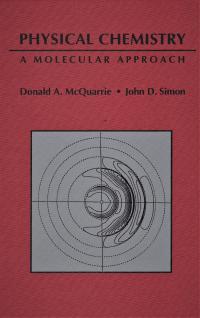Physical Chemistry
Physical Chemistry
By: Donald A. McQuarrie, John D. Simon
As the first modern physical chemistry textbook to cover quantum mechanics before thermodynamics and kinetics, this book provides a contemporary approach to the study of physical chemistry.
For all sales outside of the United States, please contact Felicity Henson, fhenson@aip.org
Title information
As the first modern physical chemistry textbook to cover quantum mechanics before thermodynamics and kinetics, this book provides a contemporary approach to the study of physical chemistry. By beginning with quantum chemistry, students will learn the fundamental principles upon which all modern physical chemistry is built. The text includes a special set of “MathChapters” to review and summarize the mathematical tools required to master the material Thermodynamics is simultaneously taught from a bulk and microscopic viewpoint that enables the student to understand how bulk properties of materials are related to the properties of individual constituent molecules. This new text includes a variety of modern research topics in physical chemistry as well as hundreds of worked problems and examples.
Translated into French, Italian, Japanese, Spanish and Polish.
CONTENTS
Preface
1.The Dawn of Quantum Theory
Math Chapter A/Complex Numbers
2. The Classical Wave Equation
Math Chapter B/Probability and Statistics
3. The Schrodinger Equation and a Particle In a Box
Math Chapter C/ Vectors
4. Some Postulates and General Principles of Quantum Mechanics
Math Chapter D/ Spherical Coordinates
5. The Harmonic Oscillator and the Rigid Rotator: Two Spectroscopic Models
6. The Hydrogen Atom
Math Chapter E/ Determinants
7. Approximation Methods
8. Multielectron Atoms
9. The Chemical Bond: Diatomic Molecules
10. Bonding in Polyatomic Molecules
11. Computational Quantum Chemistry
Math Chapter F/ Matrices
12. Group Theory: The Exploitation of Symmetry
13. Molecular Spectroscopy
14. Nuclear Magnetic Resonance Spectroscopy
15. Lasers, Laser Spectroscopy, and Photochemistry
Math Chapter G/Numerical Methods
16. The Properties of Gases
Math Chapter H/Partial Derivatives
17. The Boltzmann Factor and Partition Functions
Math Chapter I/Series and Limits
18. Partition Functions and Ideal Gases
19. The First Law of Thermodynamics
Math Chapter J/ The Binomial Distribution and Stirling's Approximation
20. Entropy and the Second Law of Thermodynamics
21. Entropy and the Third Law of Thermodynamics
22. Helmholtz and Gibbs Energies
23. Phase Equilibria
24. Solutions I: Liquid-Liquid Solutions
25. Solutions II: Solid-Liquid Solutions
26. Chemical Equilibria
27. The Kinetic Theory of Gases
28. Chemical Kinetics I: Rate Laws
29. Chemical Kinetics II: Reaction Mechanisms
30. Gas-Phase Reaction Dynamics
31. Solids and Surface Chemistry
-Answers to Numerical Problems
-Index
|
“McQuarrie and Simon have developed an excellent modern physical chemistry course that should inspire us to rethink our curriculum.” “It is a superb book, to be greatly appreciated and treasured by generations of students to come. My congratulations to the authors for a task so well executed. All of us who labor to teach the dreaded P. Chem. course are in your debt.” “McQuarrie and Simon approach physical chemistry in a fashion different from most other books. The approach is pedagogically pleasing, as it builds up physical chemistry from considerations of atoms to systems containing numerous molecules.” “It is beautifully produced, with clear diagrams and nice touches, such as the short biographies of scientists that appear between chapters…(McQuarrie and Simon) set high standards and many of us, as teachers and professionals in physical chemistry, will find inspiration in, and have our aspirations raised by, this text.” “In the undergraduate quantum course here at Princeton, we use your physical chemistry textbook, which many of us affectionately call “Big Red.” I don’t think that most people expect a lot out of a physical chemistry book, except maybe to be confused. Your book, however, I found to be truly outstanding. It is both a thorough and exceptionally clear presentation of physical chemistry concepts. I have friends in the physics department who survived their very rigorous quantum courses by relying on your book because they couldn’t understand the one used in the physics class.” “A true double thumbs up! Throughout my entire undergraduate study, both thermodynamic and reaction kinetics were conducted in a very classical manner. Whereas most of the advanced courses, thermo. and reaction kinetics, conducted here in CMU are basically dealing with all kinds of microscopic phenomena. Your book has served as a very good platform to link up my previous experiences with my current study.” |
Donald A. McQuarrie
As the author of landmark chemistry books and textbooks, Donald McQuarrie's name is synonymous with excellence in chemical education. From his classic text on Statistical Mechanics to his recent quantum-first tour de force on Physical Chemistry, McQuarrie's best selling textbooks are highly acclaimed by the chemistry community. McQuarrie received his PhD from the University of Oregon, and is Professor Emeritus from the Department of Chemistry at the University of California, Davis.
John D. Simon
John D. Simon became the first George B. Geller Professor of Chemistry at Duke University in 1998. He is currently Chair Chemistry Department at Duke and a faculty member of the Biochemistry, and Ophthalmology Departments of the Duke Medical Center. John graduated from Williams College in 1979 with a B.A. in Chemistry and received his Ph.D. from Harvard University in 1983. After a postdoctoral fellowship with Professor Mostafa El-Sayed at UCLA, John joined the faculty of the Department of Chemistry at UCSD in 1985.

